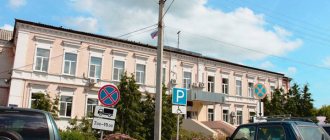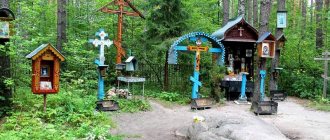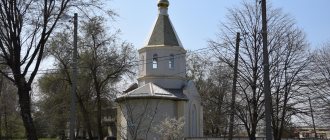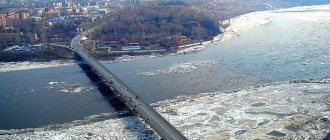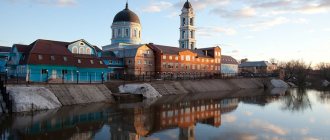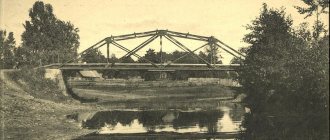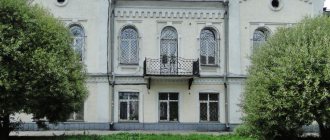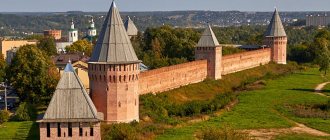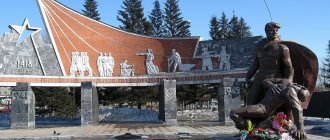White Kholunitsa
(Kirov region)
OKATO code:
33205501
Founded:
1764
Urban settlement since:
1928
City since:
1965 City of district subordination (Belokholunitsky district, Kirov region)
Center:
Belokholunitsky district
Telephone code (reference phone)
| 83364***** | 11-10-9 |
Deviation from Moscow time, hours:
0
Geographic latitude:
58°50′
Geographic longitude:
50°51′
Altitude above sea level, meters:
140 Sunrise and sunset times in the city of Belaya Kholunitsa
Private advertisements in Belaya Kholunitsa, in the Kirov region and in Russia
To add an advert
Kirov
Chipboard beds, Metal beds for students, Beds wholesale
Kirov
Turbocharger left right K27-145-02 K27-145-01 Euro-2 CZ Strakonic …
Kirov
Satellite TV customer acquisition agent
Kirov
Lego machine for making bricks Lego
123ru.net
- every minute news with a daily archive. Only here we have all the main news of the day without political censorship. “123 News” - absolutely all points of view, sober analysis, civilized debates and discussions without mutual accusations and insults. If you don’t like it, don’t want to hear it, don’t read it, read it, be mutually polite and correct in your statements. Remember that not everyone's point of view coincides with yours. Respect the opinions of others, even if you defend your views and your position. 123ru.net is a news observer. We do not impose our vision on you, we give you a snapshot of the events of the day without censorship and without cuts. News as it is—online with minute-by-minute archives for all cities and regions of Russia, Ukraine, Belarus and Abkhazia. 123ru.net - live news live! A quick search from 123ru.net is not only the opportunity to be the first to know, but also the advantage of reporting breaking news instantly in any language in the world and being heard right away. You can add your news at any moment - here.
Map
| Belaya Kholunitsa: maps |
White Kholunitsa: photo from space (Google Maps) White Kholunitsa: photo from space (Microsoft Virtual Earth)
| White Kholunitsa. Nearest cities. Distances in km. on the map (in brackets along roads) + direction. Using the hyperlink in the distance , you can get the route (information courtesy of the AutoTransInfo website) | |||
| 1 | Slobodskaya | 40 (39) | Z |
| 2 | Zuevka | 50 (116) | YU |
| 3 | Vakhrushi | 50 (51) | Z |
| 4 | Nagorsk | 53 (71) | WITH |
| 5 | Kirovo-Chepetsk | 56 (108) | SW |
| 6 | Fallonki | 67 (146) | SE |
| 7 | Kirov | 73 (72) | Z |
| 8 | Omutninsk | 79 (99) | IN |
| 9 | Oriental | 80 (113) | IN |
| 10 | Murygino | 81 (93) | Z |
| 11 | Peskovka | 89 (167) | IN |
| 12 | Pervomaisky | 93 () | Z |
| 13 | Yurya | 93 (130) | Z |
| 14 | Kearse | 96 (132) | NE |
| 15 | Kumeny | 97 (139) | SW |
| 16 | Yar (Udmurt Republic) | 98 (197) | SE |
| 17 | Bogorodskoye | 111 (187) | YU |
| 18 | Orichi | 114 (116) | SW |
| 19 | Orlov | 118 (136) | Z |
| 20 | Suna | 120 (160) | SW |
a brief description of
The city is located in the Urals, on the terraces of the river. Belaya Kholunitsa (tributary of the Vyatka), 48 km from the railway. Slobodskaya station, 82 km northeast of Kirov.
Territory (sq. km): 510
Information about the city of Belaya Kholunitsa on the Russian Wikipedia site
Historical sketch
Founded in 1764 in connection with the construction of the Novotroitsk Kholunitsky ironworks on the Kholunitsa River (the left tributary of the Vyatka). Later, this river began to be called Belaya Kholunitsa, since the river flowing somewhat to the north has long been called Black Kholunitsa, i.e. a pair of hydronyms was formed. Accordingly, the factory village was first called Kholunitsky, and then Belokholunitsky.
In the 19th century center of the Kholunitsky mining district. There was a women's school of lacemakers and a school of willow weaving (baskets, travel chests, furniture).
Since January 9, 1928, the working settlement of the Belokholunitsky plant. On July 31, 1965, the working village of Belokholunitsky was transformed into the city of Belaya Kholunitsa.
Economy
JSC "Belokholunitsky Plant" (plant of handling equipment), 2 timber industry enterprises, 2 forestry enterprises, a woodworking plant with furniture production, a branch of the building products factory named after March 8, a bakery, a butter factory, etc.
In the Belokholuninsky district, rye, wheat, oats, barley, potatoes, vegetable and fruit crops, and clover are grown. Meat and dairy cattle breeding, pig breeding, sheep breeding, etc.
Deposits of iron ore and a sulfur spring (in the village of Klimovka), as well as clay, gravel, lime, crushed stone, peat.
Main enterprises
MECHANICAL ENGINEERING
JSC "Belokholunitsky Machine Building Plant"
613200, Kirov region, Belokholunitsky district, Belaya Kholunitsa, st.
Usatovaya, 2 Offers:
Belt and screw conveyors, chain elevators, trolleys, winches, greenhouses
Culture, science, education
Historical Museum.
Museums, galleries, exhibition halls
Belokholunitsky Local Lore Museum of the Kirov Region 613200, Kirov region, Belokholunitsky district, Belaya Kholunitsa, st. Usatovaya, 4 Phone(s): (83364) 4-30-84 Website: https://www.bhmuseum.ru/
Architecture, sights
Buildings built in the 1890s One of the city’s attractions is an ancient factory pond (area 15 sq. km, the largest body of water in the region). New microdistricts with apartment buildings.
In the Belokholuninsky district - Demetrius Church (Pantyl village), St. Nicholas Church (Saryany village), All Saints Church (Vsekhsvyatskoe village).
| Population by year (thousands of inhabitants) | |||||||
| 1931 | 5.1 | 1996 | 13.0 | 2007 | 11.5 | 2015 | 10.6 |
| 1939 | 6.8 | 1998 | 12.6 | 2008 | 11.5 | 2016 | 10.6 |
| 1959 | 10.4 | 2000 | 12.2 | 2010 | 11.4 | 2017 | 10.5 |
| 1970 | 12.3 | 2001 | 12.0 | 2011 | 11.2 | 2018 | 10.4 |
| 1979 | 13.0 | 2003 | 12.0 | 2012 | 11.1 | 2019 | 10.3 |
| 1989 | 13.4 | 2005 | 11.7 | 2013 | 10.8 | 2020 | 10.1 |
| 1992 | 13.4 | 2006 | 11.6 | 2014 | 10.7 | 2021 | 10.0 |
Pedigree of the small homeland
The settlement at the Novotroitsk Kholunitsky plant arose in 1764 simultaneously with the plant. Belaya Kholunitsa received city status in 1966. The center of the district of the same name.
Located in the northeastern part of the region on the Belaya Kholunitsa River (a tributary of the Vyatka River). The distance to the regional center is 82 kilometers, to the nearest railway station in the city of Slobodskaya - 48 kilometers.
Population - 13.3 thousand people (1993).
In the second quarter of the 18th century, iron ores were discovered in the northeast of the Vyatka land. They began to mine them in the territory of the present Belokholunitsky district. Fuel was required to smelt these ores into pig iron. There was enough of it: there were plenty of untouched forests around. And in order to move factory mechanisms using water wheels and transmissions, the force of falling water is needed. And this could be done if only the river had been dammed. These are the three factors that determined the emergence of metallurgical production here, and along with it, the human population.
Prosecutor General A.I. Glebov, , brought his serfs here from nearby places and hired mining officer A.S. Yartsov to build a plant on the Klimkovka River. In 1762, the plant smelted the first cast iron. Here they originally planned to convert it into iron. But not enough water accumulated in the pond, which hampered the production process, and by order of the Berg College, Yartsov built a second plant, south of Klimkovka, on the Bolshaya (White) Kholunitsa River. In November 1764, iron forging began here from Klimkovo cast iron, delivered by river. In memory of the Trinity Kholunytsko-Verkhovyatsky monastery (male, existed since 1594, now the village of Trinity, Belokholunytsky district), which was closed that same year, the new plant was named Novotroitsky Kholunytsky. Later, when the entire Kholunytsky mining district was formed, it included, in addition to the two mentioned above, also the Bogorodsky, Nizhnetroitsky Kholunytsky, Borovsky, Chernokholunytsky and Zalazninsky plants. The plant in Belaya Kholunitsa became known as Glavnokholunytsky, and later Belokholunytsky.
The company has been producing roofing and strip iron for 145 years. It was sent in barges during the spring flood along the Belaya Kholunitsa, Vyatka, Kama rivers to the Volga, to All-Russian fairs, where it was in great demand. In 1879, the Kholunitsky factories produced 420 thousand poods of iron.
After several years of conservation (1909 - 1916), the plant in the center of the district was repurposed as an agricultural machine-building plant. From Belaya, horse-drawn plows, hillers, and then threshers, winnowers, flax rippers and other simple equipment went all over the country.
In 1941 - 1945, the White Kholunich residents produced artillery shells for the front, in which they were helped by specialists from the evacuated plant from Nikopol, and also began the production of hoisting and transport machines, which over time became the main one.
For more than two centuries of history, many outstanding Russian industrial specialists have worked at this ancient production site in the Urals. A native of the city of Zlatoust, master Vasily Stepanovich Pyatov in 1858 was the first in the world to produce armor plates using the rolling method at the Belokholunitsky plant. In 1887 - 1896, a young mining engineer, Mikhail Aleksandrovich Pavlov , “the father of Russian metallurgy,” a future academician, Hero of Socialist Labor, and laureate of the USSR State Prize, worked at the Kholunitsky factories. His first scientific works on blast furnace production were written during the years of work in Belaya Kholunitsa and Klimkovka.
From 1882 to 1901, the manager of the Kholunitsky mining district was a mining engineer, actual state councilor Andrei Andreevich von Siegel. During his tenure, factories, furnaces and other equipment were completely updated, which doubled the productivity of factories. Under A.A. von Siegel, seven buildings for schools and workshops were built, two public libraries and the Auditorium (People's House) were opened; The Kholunitsky Consumer Society has undergone significant development (the number of members has grown from 162 to 910); on the initiative of the manager, a charitable society was opened; a factory cash fund was approved, from which pensions were paid to the deserved, elderly and artisans who were injured at work. Engineer M.A. Pavlov under Siegel established a record of industrial accidents, and developed measures to prevent them.
The decoration of Belaya Kholunitsa to this day are the buildings of the main office of the plant management, the manager's house (now school No. 2), the factory store (now grocery store No. 2), and the hospital of the Kholunytsia Mining Plants, built under Siegel, two of which are still in use today.
In “Mining Journal” No. 2 for 1906, the obituary on the death of A. A. von Siegel said: “Only those who know how slowly progress moved in the Urals and with what difficulty the funds for updating factories were acquired there can fully appreciate merits of Andrei Andreevich ." In 1898, a lace making school was opened in Belaya Kholunitsa, where dozens of girls from the families of factory workers and peasants from nearby villages received a rare specialty at that time. The most capable were even sent to St. Petersburg to the Mariinsky Industrial School. In 1900, the products of Kholunitsky craftswomen were awarded a gold medal at an exhibition in Paris.
The history of the plant and the village is glorious with revolutionary traditions. Heavy exploitation, almost hard labor conditions caused strikes back in the 30s of the 19th century. The strike lasted for a whole month in 1871 and stopped only under the threat of military reprisal. The plant became the center of the proletarian struggle in 1905-1907. It was organized by a party cell that had close ties with the Vyatka Committee of the RSDLP. The streets of the city bear the names of active revolutionaries P. I. Shamurov, A. F. Elkin, M. F. Zakhvatkin, A. U. Glazyrin, P. A. Smirnov, who later became the People's Commissar of the USSR Navy, a participant in the Great Patriotic War, Hero of the Soviet Union A. M. Bastrakov and partisan nurse T. N. Usatova, who gave their lives for the Fatherland. On the slabs at the memorial monument in the Metalworkers' garden there are more than five hundred names, mostly factory workers. In total, more than a thousand of its residents did not return to their native Kholunitsa from the Great Patriotic War.
During the hard times of war, hundreds of evacuees from Ukraine, Karelia, the Baltic states, and children of besieged Leningrad found shelter and bread in Belaya Kholunitsa.
The memory of local history events and glorious fellow countrymen is immortalized by eleven memorial plaques.
On the map of the mid-19th century - one of the exhibits of the factory museum (by the way, there is another in the city - a regional historical one) in the village of the Belokholunitsky plant, only 7 streets are indicated, adjacent to the plant on the right bank. Now there are 62 streets in the city (30 in the factory part, 32 in the left bank area beyond the river), its area is 10 square kilometers.
The historical center, having lost its administrative significance, remained the center of urban industry. Here, on the right bank of the Belaya Kholunitsa River, there is a machine-building plant, which we have already begun to talk about - the leading enterprise not only of the city, but also of the region. Almost 2 thousand people work at the plant, which is almost every third adult able-bodied city dweller. In 1983, a new engineering and utility building and a block of workshops, built according to the plan of the first stage of reconstruction, came into operation. The total production area of the enterprise is now about 30 thousand square meters. The woodworking shop is located on the southwestern outskirts. In the city of Slobodsky, the plant has a transshipment base from railway to motor transport, through which metal and components are delivered and belt and screw conveyors, the main products of machine builders, are shipped to customers. They are produced about three thousand units per year. These machines mechanize the process of moving bulk and lumpy cargo in the mining, metallurgical, chemical industries, construction sites, state district power plants and thermal power plants, modern mill complexes and other industries. The plant's products are also exported.
The fate of many generations of Kholunitsky residents is connected with the plant. Metalworkers of such a class work here that they could be an honor to any plant in the country. Many have been awarded state awards. The Red Banners were transferred to the team for eternal storage for the successful completion of important tasks of the State Defense Committee of the USSR during the Great Patriotic War and for victory in the regional competition in honor of the 50th anniversary of the October Revolution.
Other city enterprises are located in the factory part. For example, the Belokholunitsky timber industry enterprise, operating since 1931, is widely known. Its mechanized lower warehouse is located on the southern outskirts, where the workshops of the Bogorodsky ironworks stood in the 19th century. Due to the depletion of the timber resource base, annual harvesting has decreased to 150 thousand cubic meters, but wood processing has increased significantly.
In 1936, the Belokholunitsky forestry enterprise, one of the best in the region, was organized. Its lower warehouse - a complex mechanized production with woodworking shops - is located in the satellite village of Sosnovka (on the western outskirts of the regional center), the remaining city from a geological exploration expedition of oil workers. The area of forests under the jurisdiction of the forestry enterprise is more than 130 thousand hectares. Reclamation column No. 5 located its base in Sosnovka.
In the factory part of the city there are also an inter-farm enterprise, a construction and repair cooperative "Vyatka", industrial bases for rural and military road builders, and a bakery.
In the left bank of Kholunytsia, the leading enterprise is a woodworking plant; its profile is furniture production, the origins of which go back to the 30s. In the same microdistrict, at the end of Volodarsky Street, an interdistrict creamery has been operating since 1969. Nearby there is a branch of the Kirov factory of stitched embroidered products named after March 8, a city utility base, a road repair site, Agropromservice and other organizations.
On the southern outskirts, across the Antonovka River, there are bases of the motor transport enterprise, Pervomaisky timber industry enterprise, a branch of the Kirov Ideal factory.
Handling and transport equipment, round timber and lumber, sets of wooden houses, log buildings of outbuildings, furniture, parquet, clothing for adults and children, hats, fur mittens, ironing boards, hoes, garden carts and much more comes from here to all regions Russia.
To a person who comes to Belaya Kholunitsa for the first time, especially on a bad autumn day, the city will seem gray and nondescript. At first glance, this is true. Three quarters of the buildings are wooden, many are already 50-80, or even 100 years old. There are just over 2,800 residential buildings, of which about 1,800 are private. Of course, there are microdistricts where the houses are brick or panel (mostly owned by a machine building plant), with water supply, sewerage and central heating, but nevertheless, the city is mostly one-story, the houses are mostly stove-heated without any amenities.
The residents of Kholuni are very proud of their pond, famous throughout the region. The area of its water surface at low water is 13 square kilometers. Clean sand on the beaches, pine forests along the shores almost like in the Baltics, the opportunity to rush with the breeze on a motor boat or under a sail, or sit with a fishing rod at dawn have made the pond a favorite vacation spot for the population and guests of the city.
There is a lot of greenery on the streets, there is a park, two gardens, and public gardens.
The buildings of the factory administration, school No. 2, hospital, and grocery store have already been mentioned. These century-old buildings are decorated with cast iron artistic castings by local craftsmen of the late 19th century. When you see them, Pushkin’s line involuntarily comes to mind: “Your fences have a cast-iron pattern...” These buildings are monuments of architecture and local history.
Of the three churches that existed in Kholunytsya, only one remained - the cemetery of All Saints. Work is underway to restore it. There are no monuments valued for skillful execution in the cemetery, with the exception of the monument to the people's teacher A.V. Khokhryakov, erected by grateful students at his grave in 1879. The three-meter pyramid is richly decorated with artistic cast iron.
On July 31, 1965, the working-class village of Belokholunitsky was transformed into a city of regional subordination, and since then Belaya has been slowly but steadily growing. A water pipeline runs for almost twenty kilometers, there are sewer lines in both parts of the city, and there are four bus routes.
The administrative center loomed in the part beyond the river on Glazyrina Street, where in 1970 the city’s first four-story building, the House of Soviets, went up. Nowadays it houses the district administration with its numerous services. In addition, in the 60-80s, a new hospital complex, a pharmacy, a secondary school No. 1, a communications center, a sports complex, a stadium, a regional library, a number of city trade stores and a regional consumer society appeared in the city. A network of commercial outlets has developed.
The city has two public libraries, two museums, two Houses of Culture, two high schools, one junior high school, a regional special boarding school for children with visual impairments, a vocational school, sports, music, and art schools. A building for secondary school No. 2 is under construction.
…A lot can be said about the people who made our city famous. About the true sowers of the reasonable, the good, the eternal, our unforgettable teachers E. I. Onchukova, V. G. Chemodanova, A. P. Myshkina - the first of those awarded state awards back in the 30-50s, about L. V. Voskresenskaya and V. A. Maksimov - honored teachers of Russia, about the teachers of the Belokholunitsky Pedagogical School A. Ya. Raspopov, N. S. Dobrynsky, K. K. Strelnikov, D. I. Shupletsov and others who in the 30-50s Within the walls of the school, more than two thousand primary school teachers were trained for schools in the region, ours and other regions.
And how can we not say about Doctor N.N. Shklyaev, through whose efforts the hospital estate of the Kholunitsky Mining Plants was built in the 90s of the 19th century, about the surgeon famous throughout the province of the early 20th century V.E. Odintsov, about the surgeon I.N. Nechaev, who worked here in the 1960s -1990s and saved hundreds of lives, about the builder of the current hospital campus, chief physician Yu. P. Kirmas...
How not to name a few more names of glorious fellow countrymen, such as laureates of state awards, automotive engineer K. P. Bulatov, Lieutenant General E. A. Shitov, full holder of the Order of Glory A. A. Saltykov, Consul General of the USSR in Iran and Turkey A. A. Krasnykh, brave polar explorer N. N. Eremin, Doctor of Medical Sciences S. G. Sukhanov, People’s Artist E. E. Shutov, world record holder runner L. M. Gurina and many others….
Key dates
1764 - foundation of the Novotroitsk Kholunitsky plant.
1858 - under the leadership of V.S. Pyatov, armor was manufactured for the first time in the world by rolling at the Kholunitsky plant.
1871 - strike of workers of the Belokholunitsky plant.
1882 - 1901 - A. A. von Siegel worked as manager of the Kholunitsky mining district.
1887 - 1896 - time of work at the Kholunitsky factories of the metallurgist M. A. Pavlov.
The 1890s were the time of construction of factory administration buildings, a manager’s house, and a hospital estate in Belaya Kholunitsa, the beginning of the installation of telephones in factories, and the time of their reconstruction.
1905 - 1907 - revolutionary events at the Belokholunitsky plant. Organization of the metalworkers' trade union.
1909 - plant closure.
1916 - resumption of plant operations. Start of production of plows.
1917 - introduction at the plant, by decision of the plant committee, of an 8-hour working day.
1918 - establishment of Soviet power in the Fedoseyevskaya volost, election of the volost executive committee.
May 1, 1923 - honoring the first Heroes of Labor of the Belokholunytsky plant.
1944 - 1946 - more than 800 machine builders were awarded orders and medals for valiant work during the Great Patriotic War.
1950 - the beginning of production of lifting and transport machines for export.
1951 - Belokholunitsky timber industry enterprise was awarded the USSR State Prize for success in the competition.
July 31, 1965 - Decree of the Presidium of the Supreme Soviet of the RSFSR on the transformation of the workers' village of Belokholunitsky into a city of regional subordination.
1982 - The State Commission accepted from the builders a new block of workshops, built according to the plan for the reconstruction of the machine building plant.
(V. A. Sitnikov, N. I. Perminova and others “Encyclopedia of the Vyatka Land” Vol. 1. Cities. Kirov. 1994.).
Notes
- ↑ 123
www.gks.ru/free_doc/doc_2016/bul_dr/mun_obr2016.rar Population of the Russian Federation by municipalities as of January 1, 2016 - Order of the Government of the Russian Federation of July 29, 2014 No. 1398-r “On approval of the list of single-industry towns”
- ↑ 12
[www.kipov.ru/rajony/belay_h/ White Kholunitsa | sights of Belokholunitsky district] - ↑ 12
[www.museums.unn.ru/CultTour/comm/leaf.phtml?lid=915 White Kholunitsa] - ↑ 12
www.bhregion.ru/public/document/settlements/1/ekonomika/1068cdaeb8230a1b4ea5130a481b3249.pdf - ↑ 12345678910111213
www.MojGorod.ru/kirovsk_obl/belholunica/index.html People's encyclopedia “My City”. White Kholunitsa - [demoscope.ru/weekly/ssp/rus70_reg2.php All-Union Population Census of 1970 The size of the urban population of the RSFSR, its territorial units, urban settlements and urban areas by gender.] (Russian). Demoscope Weekly. Retrieved September 25, 2013. [www.webcitation.org/6GDOiMstp Archived from the original on April 28, 2013].
- [demoscope.ru/weekly/ssp/rus79_reg2.php All-Union Population Census of 1979 The size of the urban population of the RSFSR, its territorial units, urban settlements and urban areas by gender.] (Russian). Demoscope Weekly. Retrieved September 25, 2013. [www.webcitation.org/6GDOjhZ5L Archived from the original on April 28, 2013].
- [demoscope.ru/weekly/ssp/rus89_reg2.php All-Union Population Census of 1989. Urban population]. [www.webcitation.org/617x0o0Pa Archived from the original on August 22, 2011].
- [www.perepis2002.ru/ct/doc/1_TOM_01_04.xls All-Russian Population Census 2002. Volume. 1, table 4. Population of Russia, federal districts, constituent entities of the Russian Federation, districts, urban settlements, rural settlements - regional centers and rural settlements with a population of 3 thousand or more]. [www.webcitation.org/65AdCU0q3 Archived from the original on February 3, 2012].
- [www.gks.ru/bgd/regl/B08_14t/IssWWW.exe/Stg/p/08.htm Cities of the Kirov region (number of inhabitants - estimate as of January 1, 2008, thousand people)]. Retrieved June 12, 2016. [www.webcitation.org/6iDNsy0V3 Archived from the original on June 12, 2016].
- [www.gks.ru/bgd/regl/B09_109/IssWWW.exe/Stg/d01/tabl-21-09.xls Number of permanent population of the Russian Federation by cities, urban-type settlements and districts as of January 1, 2009]. Retrieved January 2, 2014. [www.webcitation.org/6MJmu0z1u Archived from the original on January 2, 2014].
- [www.gks.ru/free_doc/new_site/perepis2010/croc/Documents/Vol1/pub-01-11.xlsx Population Census 2010. Population of Russia, federal districts, constituent entities of the Russian Federation, city districts, municipal districts, urban and rural settlements] (Russian). Federal State Statistics Service. Retrieved January 22, 2013. [www.webcitation.org/6GDBk0rPa Archived from the original on April 28, 2013].
- [www.gks.ru/free_doc/doc_2012/bul_dr/mun_obr2012.rar Population of the Russian Federation by municipalities. Table 35. Estimated resident population as of January 1, 2012]. Retrieved May 31, 2014. [www.webcitation.org/6PyOWbdMc Archived from the original on May 31, 2014].
- [www.gks.ru/free_doc/doc_2013/bul_dr/mun_obr2013.rar Population of the Russian Federation by municipalities as of January 1, 2013. - M.: Federal State Statistics Service Rosstat, 2013. - 528 p. (Table 33. Population of urban districts, municipal districts, urban and rural settlements, urban settlements, rural settlements)]. Retrieved November 16, 2013. [www.webcitation.org/6LAdCWSxH Archived from the original on November 16, 2013].
- [www.gks.ru/free_doc/doc_2014/bul_dr/mun_obr2014.rar Table 33. Population of the Russian Federation by municipalities as of January 1, 2014]. Retrieved August 2, 2014. [www.webcitation.org/6RWqP50QK Archived from the original on August 2, 2014].
- [www.gks.ru/free_doc/doc_2015/bul_dr/mun_obr2015.rar Population of the Russian Federation by municipalities as of January 1, 2015]. Retrieved August 6, 2015. [www.webcitation.org/6aaNzOlFO Archived from the original on August 6, 2015].
- taking into account the cities of Crimea
- [www.gks.ru/free_doc/doc_2016/bul_dr/mun_obr2016.rar Population of the Russian Federation by municipalities as of January 1, 2016. Table “31. Population of cities and towns by federal districts and constituent entities of the Russian Federation as of January 1, 2016.” RAR archive (1.0 MB)]
